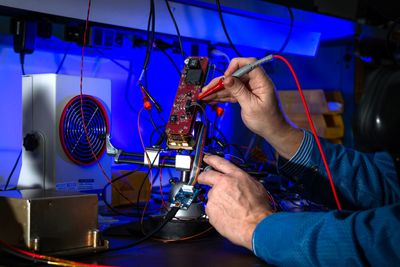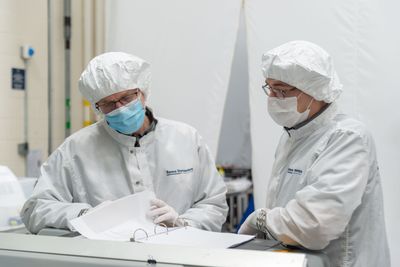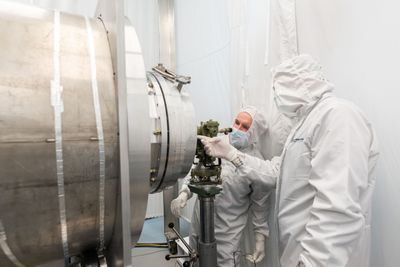Collaborate with SDL
The joint appointee role enables USU faculty and SDL to closely collaborate and increase the speed of innovation. A joint appointee is a term for both USU and SDL employees and is a reciprocal arrangement. In most cases, faculty will work with SDL as a joint appointee; however, being a joint appointee is not required.
USU faculty can collaborate with SDL by selecting to:
- Advance innovative research through SDL’s internal research and development (IRAD) program.
- Participate on externally funded programs at SDL. This includes both unclassified and classified projects.

Internal Research & Development
SDL pursues cutting-edge IRAD projects that align with our strategic thrust areas and are relevant to our customers’ current and future needs.

Unclassified Externally Funded Research
Unclassified research at SDL and USU is common. Joint research opportunities are highly encouraged.

Classified Externally Funded Research
SDL seeks to work collaboratively with USU faculty on externally funded research that is classified and supports our customers’ needs.
Key Information
SDL performs contract-based work for the federal government and is required to ensure compliance with all applicable federal laws and agency regulations. The following sections describe key information about working with SDL.
Timekeeping & Billing
To ensure accurate cost reporting, timekeeping, and billing, each agreement will have a set period of performance and clear delivery expectations. USU faculty must perform the work in the period allowed, and invoices must be submitted monthly to ensure proper inclusion in SDL’s reporting and invoicing process.
Consulting Service Leave
USU faculty have the option to use their consulting service leave per USU guidelines in support of SDL projects. Faculty using their consulting service leave are paid directly by SDL. Kuali data entry is not set up to handle consulting service leave. Time constraints for project deliverables (IRAD and externally funded) will be a key determination in deciding if consulting service leave is an acceptable contracting method for SDL.
USU faculty who want to use consulting service leave must:
- Review the USU Consulting Service Policy.
- Complete the Consulting Leave form.
- Email a copy of the approved form to SDL Human Resources.
SDL Timecard Employee
USU faculty, staff, and students may work with SDL as timecard employees per USU guidelines in support of SDL projects. Timecard employees are paid directly by SDL. Timecard work does not count toward USU tenure. For faculty, SDL requires a completed Consulting Leave form. No such forms are required for staff or students.
Citizenship/US Person Eligibility
- Most research conducted by or for SDL is export controlled. US Persons may conduct export-controlled research. A US Person is a US Citizen or National, a US Lawful Permanent Resident (green card status), or a person who has been granted Asylum/Refugee Status.
- Much of SDL research includes CUI (for example, Controlled Technical Information). Access to CUI depends on the type of CUI and the access restrictions placed thereon by the customer.
- Foreign Person participation on SDL research will be considered on a case-by-case basis to ensure compliance with US export control laws and/or CUI restrictions/markings. Foreign Persons who are bona fide and full-time regular employees of USU may perform export-controlled research subcontracted to USU if the employee and USU comply with ITAR exemption § 125.4(a)(10), if the research is “fundamental research” as defined by the EAR (see EAR § 734.8), or if the research is not restricted under CUI regulations/markings. A Foreign Person is anyone who is NOT a US Person.
- Classified research may only be performed by a US Citizen with the requisite security clearance.
Student Eligibility
- USU undergraduate or graduate students may work on SDL IRAD and unclassified projects. However, if the effort is deemed to be export controlled, mentions export-controlled matters, or contains access to CUI, then only students who are US Persons will be authorized per export control laws and USU policies.
- Only PhD students will be considered for security clearances. PhD students must be US Citizens and able to pass the pre-screening interview questions. Additionally, the USU faculty member requesting the student’s clearance must state the necessity for, duration of, and involvement level required for the PhD student. The approval to submit the clearance paperwork is at SDL’s discretion and will be authorized on a case-by-case basis.
Training Requirements
SDL requires USU joint appointees to complete and stay current on required training based on the location, customer, and type of work performed.
Work Location & Equipment Access
Work will be performed in the location dictated by the type of contract work. Generally, unclassified and IRAD efforts may be performed at USU, while classified contract work must be performed in an SDL facility. Work location will be discussed and determined at contract award based on clear understanding of work scope. SDL will supply access to equipment and services as needed.
Publications
The standard government publication restrictions are applicable to all externally funded projects. Publications must gain approval via SDL’s Technical Information Clearance (TIC) process. For SDL IRAD efforts, publications must be reviewed by SDL’s attorney for intellectual property and export control compliance.
Export Control
Export control requirements will be followed and are based on US export control regulations. SDL’s Empowered Official will make export control decisions and engage with USU’s Research Integrity & Compliance officers as needed.
Strategic Thrust Areas
Use this list to identify the SDL thrust area(s) to which your research best applies. Include your desired strategic thrust area when communicating with SDL.
C4ISR Systems
Command, Control, Communications, Computers, Intelligence, Surveillance, and Reconnaissance
- Data science and engineering
- Artificial intelligence, machine learning, and decision-making applications in analytics, autonomy, cyber, etc.
- Algorithms, digital sensor processing, and exploitation
- Small, autonomous, and intelligent sensors and systems
- Radar/lidar technology development and applications
- Open systems architecture and interoperability
- Cyber technologies
- Digital engineering
- Modeling and simulation
- Reengineering/technical insertion
- Strategic deterrence systems and operations
Civil & Commercial Space
- High-reliability spacecraft: CubeSat to ESPA class
- Deep space radios
- Flight thermal capabilities
- Sensor calibration/testing capabilities
- Advanced space instrumentation/sensor systems or subsystems
- Small satellite instrument/sensor payloads
- Space camera systems and supporting technologies
- Surface-deployed support systems
Strategic & Military Space
Missile Defense
- Missile detection and tracking
- Mission data processing, algorithms, and data analysis
- Laser and directed energy applications
- Digital engineering, model-based engineering, and model-based systems engineering
- Hypersonic technologies and analysis
- Sensor systems engineering and integration
Satellite Technologies
- Expanding SDL’s leadership in execution of unique and state-of-the-art missions
- Reduction in spacecraft lead times and rework
- Autonomy and on-orbit operations to provide a “SmartBus”
- Improving spacecraft component capabilities and performance
- Subject matter expert tools and resources to quickly respond to customer needs
Sensor Systems
- Focal plan architectures and maturation
- Optics concepts for rendezvous and proximity operations and space domain awareness
- Sensor innovation and on-orbit processing
- Ionospheric impacts and applications
- Field-worthy quantum navigation and timing applications
Software Systems
- Mission planning application development
- Satellite data processing and management
- Software architecture modeling (process and tools)
- Mission systems data visualization